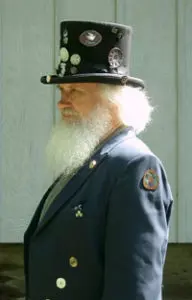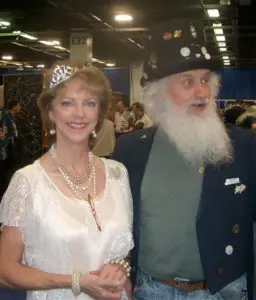The Duke of Pearl, sometimes also referred to as “Chuck Erikson”, suffered his first exposure to pearl as an inlay material during his partnership in 1963-64 as a co-owner of The House of Banjos, in Denver, Colorado. After a couple of brief sessions with local banjo makers Art Christianson (Christy Banjos), and Chuck Ogsbury (Ode, and later Ome Banjos), he began seriously experimenting with banjo construction, including his first crude attacks on inlay work.

After returning to his native southern California in late 1964, in January of 1965 Chuck rented a small industrial shop space in Van Nuys, hung out his new Erika Banjos shingle, and managed to convince an unsuspecting customer that he was an experienced builder while failing to mention he’d never actually made a complete instrument at that point! Three other established left-coast luthiers, Roy Noble, Bob Givens, and R.C. Allen, supplied enough basic coaching to sidestep disaster, and referrals began arriving.
Specializing in 5-string Bluegrass banjos, which are traditionally rich in pearl inlay work, Chuck immediately discovered that small shops had no access to dependable shell sources. What was available was not only expensive, but often of such poor quality as to be almost unusable, usually containing blanks not only marked by large factories as rejects, but sometimes having had inlays already cut from them!
El Monte-based Givens had been getting good shell from a very tiny family-owned processor in nearby Wilmington and wasn’t especially interested in sharing this advantage with anyone else. He did finally pass the information along, not knowing that the owner had that same week decided to close the twenty-year business. Chuck’s first visit on January 28, 1968 found him returning home $1,200.00 poorer, pulling a rental trailer full of dusty old grinders, saws, a vacuum, and several disintegrating boxes full of Australian ocean pearl oyster shells!
At first concerned only about supplying his own modest needs, within a year other west coast luthier friends had pestered him into just “grinding a little extra” for them. Word spread, the phone rang, and builders he didn’t even know from places he’d never heard of began talking him into taking “Orders”. By 1970, Chuck was also cutting Red and Green abalone from coastal commercial fisheries and by the mid-70’s had added Mexican Pink ab., Black ab., and African Green sea snail. Additionally, he began dealing ebony and other hard-to-find rare hardwoods, several types of ivory, farmed tortoiseshell, custom-formulated epoxies, vintage instrument inlay patterns, high quality banjo components, offered an extremely popular fingerboard fret-slotting service, and had to expand his shop space and hire several employees.
It was getting so impossible to find time to actually finish the instrument orders gathering dust on his workbenches, that the last banjo finished (in 1982) took eleven years to deliver! An innovative instrument maker, Chuck’s personal fascination with the specialized art of inlay led to experimentation with radically non-traditional designs and techniques, tough to sell to most Folkies and Bluegrassers at the time, but generating interest with the rock-and-roll crowd, and paving the way for the next generation of inlayists. The extremely precise machining of his shell materials, and the development of a sophisticated system of sorting and classifying new and different grades of shell, introduced standards copied and used to this day throughout the industry.

In November of 1979, sudden sale of the property in which he had rented a shop for fourteen years forced a frantic scramble to relocate. When the pearl dust cleared, the little northern Sierra foothills town of Grass Valley found itself home to an interesting new resident! Chuck continued to cut shell for a couple of years, but during the severe national economic slump of 1981-82, which impacted sales of the types of high-end instruments in which shell was featured, he shut it all down, put everything in storage, and did the logical thing, becoming a professional gold miner.
Working under-water in a remote snow-fed creek on his own claims, 6,000 feet up in the high-Sierra Mother-Lode backcountry, and using a home-built V.W. engine-powered floating suction dredge (with an 8″ diameter hose, and a “hookah” to pump air to the diver), Chuck found enough gold to clear $10.00 an hour, about double what he’d ever made building instruments! In the winter months when mining was impossible, he fabricated nine types of specialized signs used to mark mining claims, sold gift shops decorative “animals on sticks” made from old weathered wood, and ran a scrap metals business. During the four summers he mined, a total of five troy pounds of nuggets were liberated from the bedrock. His mining ended in early 1985 because of a severely broken arm and his marriage to Cheryl (which he claims are unrelated events). The gold he’d managed to hang on to was sold to partially finance building a two-story log home on five acres in the pines.
On February 25, 1989 the newly-formed Montana Division of the Gibson Guitar Co. purchased Chuck’s old shell business, which had been dismantled and stored for the past seven years, the “Erika Mfg. Division” being intended to not only supply their factory’s considerable use, but to again offer inlay materials to the industry at large. But by year’s end, Gibson decided to provide only their own in-house needs, and by lifting an existing non-compete agreement allowed Chuck to once again pursue the open market. By this time, he had been actively collecting tons of Red abalone shells from northern California commercial abalone harvesters with the understanding that Gibson would soon be processing them; but since Gibson used white M.O.P. almost exclusively, their decision not to sell outside the factory forced him to find other buyers for the shells. A large South Korean company began taking as much graded raw abalone shell as could be supplied, about four or five tons a month! For many years they had been manufacturing beads, buttons, jewelry, watch bands and faces, and the paper-thin shell veneers so widely used across Asia, and offered to produce proprietary western-style shell inlay products if Chuck could develop a market in the U.S.A. Now, one of Chuck’s early pearly shell customers since the late 60’s was east coast guitar maker Larry Sifel, who tooled up and became a shell processor following Chuck’s departure from the industry in 1981.
After being reassured by his old friend Larry, (operating since 1975 as Pearlworks), that food wouldn’t disappear off his family’s table if they re-entered the business, Chuck and Cheryl made an eight-day trip in October of 1991 to Seoul lugging a beat-up old suitcase full of raw shells and marking pens, in order to personally train their first technicians. While there, they were awed by the sheer tonnage of shell veneer being produced, a material almost unknown in the western hemisphere, and returned with several ribbon-tied bundles of samples. Excepting its use on a few veneered guitar peghead overlays and tuner knobs, its delicacy along with difficulties in handling and machining limited its usefulness in musical instrument work. Larry and Chuck decided to try stacking and gluing a few veneers together, cut a shape from the stack, and then soak the layers apart to get easy multiples of the shape. At some point, they dimly realized that if the layers were left glued together the result could be a gigantic “solid” inlay blank, much larger than can be produced by any other means. This would solve a huge problem that shell workers have struggled with since prehistoric times: having to work with and fit together many tiny bits of shell when fabricating large or complex inlays. Endless technical difficulties needed to be resolved, but excellent working relationships with their Korean craftsmen made it just a matter of time before trustworthy shell laminates would become widely available.

It was during this period that the now famous Duke (and Duchess) of Pearl personae were adopted, with their first full-regalia public appearance at a Vermillion, S. Dakota luthier’s convention (G.A.L.) in June, 1992. The idea actually shares two origins: with customers who had adopted the habit of coming into the Van Nuys shop singing an altered version of the old hit “Duke of Earl”, and with England’s pearl button-bedecked Coster class of Pearlie Royalty! For those unfortunates who may never have held audience with Their Pearlnesses, the Duke is distinguished by his unruly, even frightening, long white hair and beard, crudely mended Levi trousers, black accessorized t-shirt, a top hat and long-tailed tux coat both modestly appointed with a selection of old pearl buttons, pins, charms, and inlay samples, the coat back further enhanced with a large applied pearl-festooned wedding gown panel; his Duchess is resplendent in an old pearl-encrusted wedding dress, fetchingly short enough to reveal her scuffed leather hiking boots and Mickey Mouse socks, while draped with an overabundance of gaudy fake pearl brooches, bracelets, necklaces, earrings, and a tasteless pearly tiara worn at a rakish angle!
Working closely with C.F. Martin Guitar Co., Taylor Guitars, and P.R.S. Guitars, the new laminates were tested using actual production techniques, remaining problems were corrected, and on July 7, 1998 the first of three U.S. patents were awarded to Chuck and Larry. Referred to as “Abalam®” (or Ablam), and “Gravlam” (later discontinued), this material has changed forever the way shell inlay is done (which is detailed in our product descriptions).
Up to this point Chuck and Cheryl had managed to supply an entire industry from a converted upstairs bedroom in their log home, with the output of 110 full-time Korean and Indonesian employees. But there were big changes at the Castle on May 22, 2003 when all inventory and sales were moved to Manchester, Maryland, as Larry and his factory manager Jeff Harding became 50% partners in the new Duke of Pearl, LLC. In less than a year, the Castle Nacreshops were again moved to Hanover, Pennsylvania, under the sovereign but benevolent rule of Vice-Chancellor of Inlay Sir Frank Eskra, and Her Worshipful Pearlkeep Debbie. In September, 2012, the business was moved to Lusby, Maryland, where it shares space with Aulson Inlay and where both business offices are managed by Her Worshipful Pearlkeep, Lady Ellen Aulson.

On January 20, 2021, after a 6 year struggle with Lewy body dementia, everyone’s beloved Duchess finally joined her savior in heaven, but Cheryl’s memory and influence will always be associated with the ongoing business wherever it leads. She especially enjoyed visiting with the luthiers they’ve known, considered being with them “safer than being in a Baptist parking lot”, and could never understand why such likable characters weren’t all married!
Ever progressive, The Duke has now flamboyantly slithered into the 21st century with newly-found internet skills, to which this website hopefully testifies, and as always remains available to his adoring subjects for “tech-support” and personal counseling. His Dukeness will continue to be tastelessly conspicuous at places where luthiers and tabletiers congregate, but will be amusing himself trying to devise important, strange, and shocking new shell tricks which will hopefully deepen your nacreous addictions. Wild suggestions will be gleefully welcomed at the California Nacretory!
Find out more about Duke of Pearl (Exotic Inlay Materials to the World)
